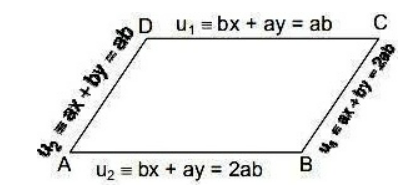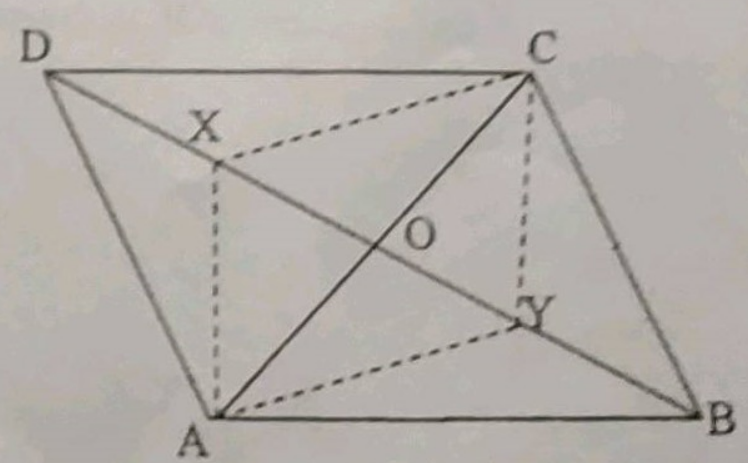In a parallelogram as shown in the figure (a≠b) : equation of the diagonal AC is (a+b)x+(a+b)y=3ab
Step by step video & image solution for In a parallelogram as shown in the figure (a != b) : equation of the diagonal AC is (a + b) x + (a + b)y = 3 ab by Maths experts to help you in doubts & scoring excellent marks in Class 12 exams.
Similar Questions
In a parallelogram as shown in the figure (a≠b) : equation of the diagonal AC is (a+b)x+(a+b)y=3ab
View SolutionIn a parallelogram as shown in the figure (a≠b)

Prove that the equation of the diagonal AC is (a+b)x+(a+b)y=3abView SolutionLet ABCD be a parallelogram the equation of whose diagonals are AC:x+2y=3; BD: 2x + y = 3. If length of diagonalAC=4 units and area of ABCD=8 sq. units. Find the length of the other diagonal is a. 10/3 b. 2 c. 20/3 d. None of these
View SolutionABCD is a parallelogram. x + 2y = 3 and 2x + y = 3 are the equations of the diagonals AC and BD respectively. AC = 4 units and area of parallelogram ABCD is 8 sq. units then The length of BC is equal to
View SolutionLet ABCD be a parallelogram the equation of whose diagonals are AC:x+2y=3; BD:2x+y=3. If length of diagonal AC=4 units and area of ABCD=8 sq. units. Then
(i) The length of the other diagonal is
(ii) the length of side AB is equal toView SolutionIn Figure, ABCD is a parallelogram and X and Y are points on the diagonal BD such that DX=BY . Prove that AXCY is a parallelogram (ii) AX=CY, AY=CX AYB ≅CXD (iv) AXD≅ CYB
View SolutionIn Figure, ABCD is a parallelogram and X and Y are points on the diagonal BD such that DX=BY . Prove that AXCY is a parallelogram (ii) AX=CY, AY=CX AYB ≅CXD (iv) AXD≅ CYB
 View Solution
View Solution3x−2y+1=0and2x−y=0 are the equation of the sides ABandAD of the parallelogram ABCD and the equation of a diagonal of the parallelogram is 5x−3y−1=0. The equation of the other diagonal of the parallelogram is : (A) x−y+1=0 (B) x−y−1=0 (C) 3x+5y+13=0 (D) 3x+5y=13
View SolutionLet ABCD be a parallelogram the equation of whose diagonals are AC:x+2y=3; BD: 2x + y = 3. If length of diagonalAC=4 units and area of ABCD=8 sq. units. (i) The length of the other diagonal is (ii) the length of side AB is equal to
View SolutionIn Figure, ABCD is a parallelogram and X and Y are points on the diagonal BD such that DX=BY . Prove that AXCY is a parallelogram (ii) AX=CY, AY=CX (iii) AYB ≅CXD (iv) AXD≅ CYB
View Solution

